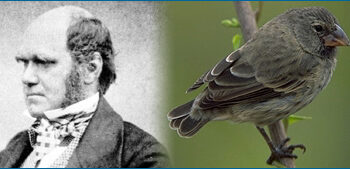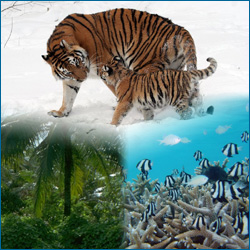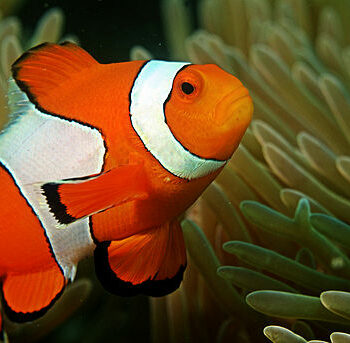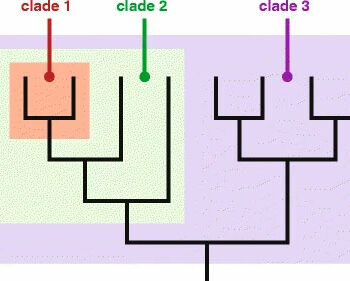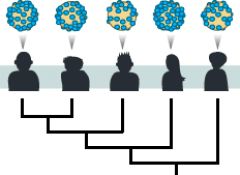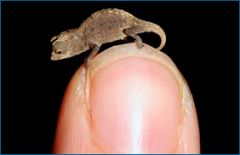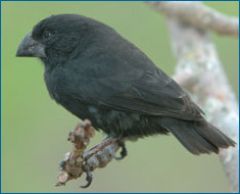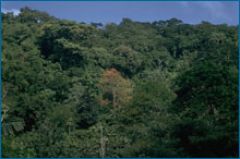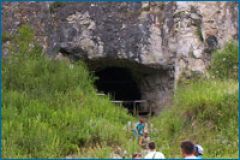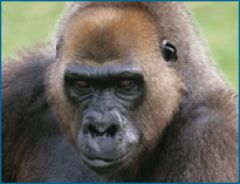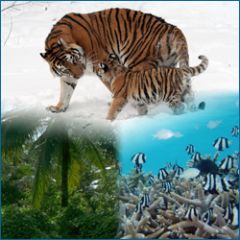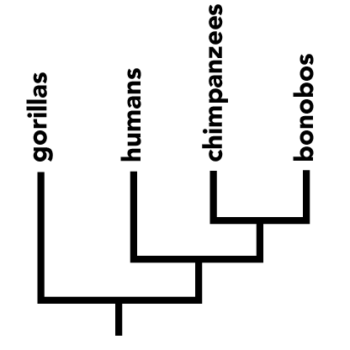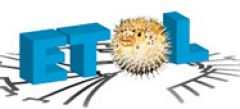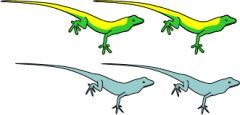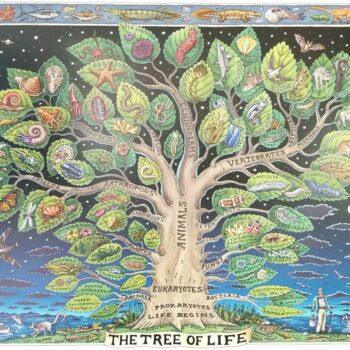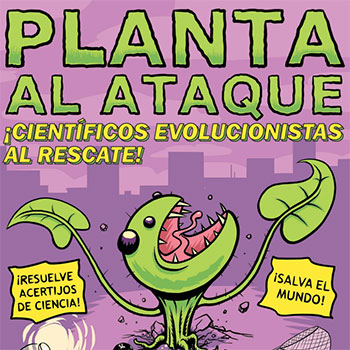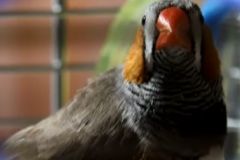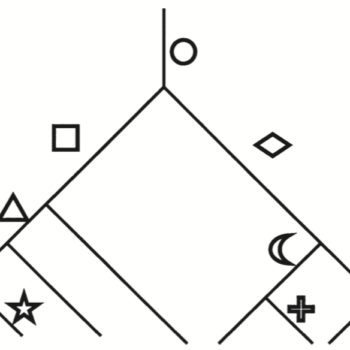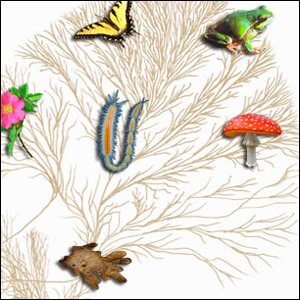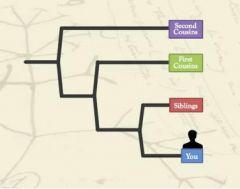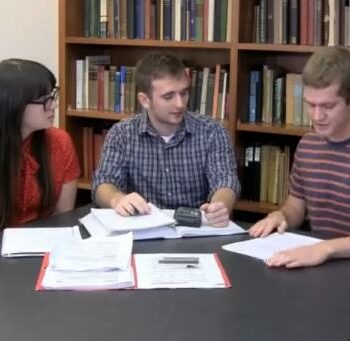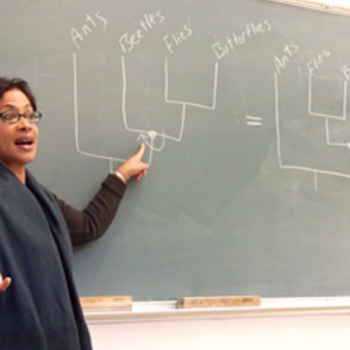Found 34 resources for the concept:
Evolutionary trees (i.e. phylogenies or cladograms) portray hypotheses about evolutionary relationships.
¡Feliz cumpleaños número 200, Darwin!
Grade Level(s):
- 9-12
- 13-16
- General
Source:
- UC Museum of Paleontology
Resource type:
- Evo in the News article
Time: 30 minutes
Overview
Este 12 de febrero se cumplirían 200 años del nacimiento de Charles Darwin, y todo el mundo esta invitado a la fiesta. Numerosos grupos alrededor del mundo — desde niños en las escuelas primarias, hasta museos e iglesias — celebraran la ciencia de la evolución con conferencias públicas, clases, obras teatrales, exhibiciones artísticas y muchísimas galletas con forma de tortugas. 'Evolución en las noticias' de este mes contribuye a la celebración mediante la revisión de un tema cercano y querido por Darwin: los pinzones de Galápagos...
¿Decisiones de conservación difíciles? Pregúntale a la evolución
Grade Level(s):
- 9-12
- 13-16
- General
Source:
- UC Museum of Paleontology
Resource type:
- Evo in the News article
Time: 20 minutes
Overview
¿Si tu casa se incendiara, que es lo que te llevarías cuando estés huyendo? La decisión puede ser difícil entre juguetes de niños, álbumes de fotos y documentos importantes compitiendo por tu atención. Desafortunadamente, nos enfrentamos con una decisión difícil cuando tenemos que definir nuestros esfuerzos de conservación. Las actividades humanas podrían estar desencadenado la sexta extinción masiva de la Tierra...
A fisheye view of the tree of life
Grade Level(s):
- 9-12
- 13-16
- General
Source:
- UC Museum of Paleontology
Resource type:
- Interactive
Overview
This interactive phylogeny of the ray-finned fishes lets users dynamically explore the evolution of fish traits, as well as read stories about the evolution of unusual characteristics such as bioluminescence and venom.
A name by any other tree
Grade Level(s):
- 6-8
- 9-12
- 13-16
- General
Source:
- Evolution: Education and Outreach
Resource type:
- Article
Time: 35 minutes
Overview
Phylogenetics has affected almost every area of biology - even the most basic one: how we classify organisms. Find out how phylogenetic classification works and what its advantages are.
This article appears at SpringerLink.
Evo in the News: A new look at dinosaur fossils pushes back the evolution of feathered wings
Grade Level(s):
- 9-12
- 13-16
Source:
- UC Museum of Paleontology
Resource type:
- Evo in the News article
Time: 20 minutes
Overview
This news brief, from November 2012, describes what a new dinosaur fossil from North America has to tell us about the evolution of feathers.
Evo in the news: Evolutionary evidence takes the stand
Grade Level(s):
- 9-12
- 13-16
- General
Source:
- UC Museum of Paleontology
Resource type:
- Evo in the News article
Time: 20 minutes
Overview
This news brief, from January of 2007, describes the role of phylogenetic evidence in a Libyan court case. Six medical workers have been convicted of injecting children with HIV-tainted blood - but the evolutionary history of the virus paints a different picture.
Evo in the News: Evolutionary history in a tiny package
Grade Level(s):
- 9-12
- 13-16
Source:
- UC Museum of Paleontology
Resource type:
- Evo in the News article
Time: 20 minutes
Overview
This news brief, from March 2012, describes the discovery four new species — all miniature chameleons — and explores the concept of island dwarfism.
Evo in the news: Happy 200th, Darwin!
Grade Level(s):
- 9-12
- 13-16
- General
Source:
- UC Museum of Paleontology
Resource type:
- Evo in the News article
Time: 30 minutes
Overview
This news brief, from February 2009, celebrates Darwin's bicentennial by examining what we've learned about the evolution of the Galapagos finches since Darwin's time.
Evo in the news: Hotspots for evolution
Grade Level(s):
- 9-12
- 13-16
- General
Source:
- UC Museum of Paleontology
Resource type:
- Evo in the News article
Time: 15 minutes
Overview
Why are there so many different species in the tropics? This news brief, from June 2006, suggests why: warmer weather may be linked to a quicker pace for evolution.
Evo in the news: Making sense of ancient hominin DNA
Grade Level(s):
- 9-12
- 13-16
- Advanced
- General
Source:
- UC Museum of Paleontology
Resource type:
- Evo in the News article
Time: 10 minutes
Overview
In March 2010 German researchers announced that they had managed to extract DNA from the 40,000 year old fossil bone from a child discovered in a Siberian cave and that it didn't match up to the known genetic sequences of either humans or Neanderthals! This news brief examines the evidence in more detail and considers what that evidence might — or might not — mean about such claims.
Evo in the news: Omicron and the case of the hidden evolution
Grade Level(s):
- 9-12
- 13-16
- General
Source:
- UC Museum of Paleontology
Resource type:
- Evo in the News article
Time: 30 min
Overview
This news brief from January 2022, explores the evolutionary mystery at the heart of the Omicron COVID-19 surge.
Evo in the news: Quick bites and quirky adaptations
Grade Level(s):
- 9-12
- 13-16
- General
Source:
- UC Museum of Paleontology
Resource type:
- Evo in the News article
Time: 15 minutes
Overview
Trap-jaw ants made headlines with the record-breaking speed of their jaws and a quirky behavior: flinging themselves into the air using the power of their mandibles. This news brief from October 2006 reveals the evolutionary story behind the headlines.
Evo in the news: Spreading disease on evolutionary timescales
Grade Level(s):
- 9-12
- 13-16
- General
Source:
- UC Museum of Paleontology
Resource type:
- Evo in the News article
Time: 10 minutes
Overview
Most infectious diseases that we are familiar with are passed from human to human; however, on evolutionary timescales, pathogens don't necessarily respect species boundaries. This news brief from November 2010 examines a recently discovered case of disease swapping among species involving a deadly strain of malaria.
Evo in the news: Tough conservation choices? Ask evolution
Grade Level(s):
- 9-12
- 13-16
- General
Source:
- UC Museum of Paleontology
Resource type:
- Evo in the News article
Time: 20 minutes
Overview
The earth is facing a biodiversity crisis. Nearly 50% of animal and plant species could disappear within our lifetime. To stem this rapid loss of biodiversity, we'll need to act quickly — but where should we begin? This news brief, from December 2008, explains how evolutionary history can help us set conservation priorities.
Evolution of human skin color
Grade Level(s):
- 9-12
- 13-16
Source:
- Smithsonian National Museum of Natural History
Resource type:
- Classroom activity
Time: Seven to ten 50 minute class periods
Overview
Students examine evidence for the relationship between UV and melanin in other animals; investigate the genetic basis for constitutive skin color humans; learn to test for natural selection in mouse fur color; investigate how interactions between UV and skin color in humans can affect fitness; and explore data on migrations and gene frequency to show convergent evolution of skin color.
Evolutionary trees and patterns in the history of life
Grade Level(s):
- 9-12
- General
Source:
- UC Museum of Paleontology
Resource type:
- Tutorial
Time: 30-40 minutes
Overview
Scientists use many different lines of evidence to reconstruct the evolutionary trees that show how species are related.
This article is located within Evolution 101.
Evolutionary trees from the tabloids and beyond
Grade Level(s):
- 9-12
- 13-16
- General
Source:
- Evolution: Education and Outreach
Resource type:
- Article
Time: 30 minutes
Overview
This article describes practical applications of phylogenetics, focusing on intriguing cases ripe for deployment in classrooms — like using phylogenetics to investigate crimes.
This article appears at SpringerLink.
Investigating a Deep Sea Mystery
Grade Level(s):
- 9-12
Source:
- ETOL
Resource type:
- Lab activity
Time: 4-5 class periods
Overview
In this lab activity, students examine authentic morphological and phylogenetic data of three fish families and then pose and test alternative hypotheses about the fishes' classification.
Island biogeography and evolution: Solving a phylogenetic puzzle using molecular genetics
Grade Level(s):
- 9-12
- 13-16
Source:
- Filson, R.P.
Resource type:
- Lab activity
Time: Two full class periods
Overview
Students focus on the evolution of three species of lizards using real data sets — geographical and geological data, then morphology, and finally molecular data — to determine possible phylogenetic explanations.
La historia de la vida: La observación de los patrones
Grade Level(s):
- 9-12
- General
Source:
- UC Museum of Paleontology
Resource type:
- Tutorial
Time: 30-40 minutes
Overview
La ciencia usa muchas evidencias diferentes para reconstruir los árboles filogenéticos que nos muestran como se relacionan las especies entre sí.
Este artículo se encuentra en Evolución 101.
Making 3D phylogenetic trees with mobiles
Grade Level(s):
- 9-12
Source:
- Carolina
Resource type:
- Classroom activity
Time: 30 minutes
Overview
Students create three-dimensional trees in the form of mobiles so that the branching nodes pivot. Students can manipulate the mobile to see the relationships more clearly and combat common misconceptions about trees.
Modeling Evolutionary Relationships with Trees
Grade Level(s):
- 6-8
- 9-12
Source:
- Shape of Life
Resource type:
- Classroom activity
Time: 100-120 minutes
Overview
In this lesson, students will examine a beautiful tree of life poster by artist Ray Troll and use it as a launchpad to explore evolutionary, or phylogenetic trees. Students will take a pre-assessment to address misconceptions about phylogenetic trees before completing a modeling activity to give them a better understanding of how trees are used to model evolutionary relationships.
Omicron y el caso de la evolución escondida
Grade Level(s):
- 9-12
- 13-16
- General
Source:
- UC Museum of Paleontology
Resource type:
- Evo in the News article
Time: 30 min
Overview
Durante el último mes, las cepas del SARS-CoV-2 Omicron han dominado los noticiarios del mundo. Esta variante de rápida transmisión ha llevado a limitar viajes, a cancelar planes de vacaciones, al agotamiento de los kits de pruebas, a la vuelta de los confinamientos, y además a un asombroso número de nuevos casos de COVID-19. Los científicos rápidamente se han puesto a estudiar Omicron, intentando entender qué tan rápido se transmite, qué tanto nos enferma, y si es resistente a los tratamientos, a las vacunas, y a los anticuerpos de infecciones de COVID previas. Necesitamos revisar todas estas cuestiones porque Omicron es muy diferente de otras cepas de coronavirus. Omicron ha acumulado más de 50 nuevas mutaciones en comparación con la cepa que empezó la pandemia. Además Omicron no es un descendiente de la cepa Delta, responsable de la anterior ola de infecciones. De hecho, Omicron es tan diferente de otras variantes que parece que ha estado evolucionando por su cuenta durante muchos meses. Y esto nos conduce a otro misterio que los científicos están tratando de resolver: ¿dónde estaba Omicron escondido mientras toda esta evolución tenía lugar?
Plant on a Rampage
Grade Level(s):
- 6-8
- 9-12
Source:
- UC Museum of Paleontology
Resource type:
- Classroom activity
- Comic
Time: 50 minutes
Overview
In this printable comic/activity book, you'll meet scientists who use evolutionary ideas to solve medical problems. You'll also learn about evolutionary trees while you solve science puzzles and complete a craft.
Planta al ataque
Grade Level(s):
- 6-8
- 9-12
Source:
- UC Museum of Paleontology
Resource type:
- Classroom activity
- Comic
Time: 50 minutes
Overview
En este cómic/libro de actividades, conocerás a científicos que utilizan ideas evolutivas para resolver problemas médicos. También aprenderás sobre los árboles evolutivos mientras resuelves rompecabezas científicos y completas una actividad.
Predicting evolutionary relationships
Grade Level(s):
- 9-12
Source:
- NOVA
Resource type:
- Classroom activity
Time: 1 hour
Overview
Students compare the sequence of amino acids in a gene shared between humans and six other organisms and infer evolutionary relationships among the species.
The great clade race: Zombie Edition
Grade Level(s):
- 9-12
- 13-16
Source:
- Martindale, Rowan and Goldsmith, David
Resource type:
- Classroom activity
Time: 30-50 minutes
Overview
This activity uses a simple puzzle to get students to use cladistic thinking without bogging them down with terminology.
Tree of Life
Grade Level(s):
- 9-12
- 13-16
Source:
- Tree of Life
Resource type:
- Interactive
Time: 1 class period
Overview
This interactive web resource allows you to follow any branch on the tree of life to find out how scientists hypothesize all the species on Earth (plus some extinct lineages) are related to one another.
This resource appears at the Tree of Life website.
Tree of Life poster without images (large)
Grade Level(s):
- 3-5
- 6-8
- 9-12
- 13-16
- General
Source:
- UC Museum of Paleontology
Resource type:
- Poster
Time: 2-10 minutes
Overview
Print this 28x36" poster for your classroom wall. For ideas about how to use the poster in your class, visit Two- and Ten-minute Trees.
Tree of Life poster without images (medium)
Grade Level(s):
- 3-5
- 6-8
- 9-12
- 13-16
- General
Source:
- UC Museum of Paleontology
Resource type:
- Poster
Time: 2-10 minutes
Overview
Print this 18x24" poster for your classroom wall. For ideas about how to use the poster in your class, visit Two- and Ten-minute Trees">Two- and Ten-minute Trees.
Tree thinking basics
Grade Level(s):
- 9-12
- 13-16
- General
Source:
- National Evolutionary Synthesis Center
Resource type:
- Video
Time: 6 minutes
Overview
Tree thinking, or phylogenetics, is an important way of understanding evolutionary relationships. Reading trees correctly can pose some challenges. This video introduces the basics of three reading and addresses common problems in tree reading.
This resource is available from the National Evolutionary Synthesis Center
Tree thinking challenges
Grade Level(s):
- 9-12
- 13-16
- General
Source:
- National Evolutionary Synthesis Center
Resource type:
- Video
Time: 10 minutes
Overview
In the this interactive video, college students guide viewers through problems on phylogenetics and address some of the misconceptions that many students have with the subject.
This resource is available from the National Evolutionary Synthesis Center
Two- and ten-minute trees
Grade Level(s):
- 3-5
- 6-8
- 9-12
- 13-16
Source:
- UC Museum of Paleontology
Resource type:
- Classroom activity
Time: 2-10 minutes
Overview
Use these quick and simple classroom activities to better develop your students' tree-thinking skills. Each takes just a few minutes and helps reinforce key ideas about tree reading and common ancestry.
What does it mean to be human?
Grade Level(s):
- 9-12
- 13-16
Source:
- Smithsonian National Museum of Natural History
Resource type:
- Classroom activity
Time: 8 x 50-minute class periods
Overview
In this set of advanced lessons, students use different types of data to infer/interpret phylogenies among domains, within the vertebrates, and within primates while reflecting on how they answer the question "What do you think it means to be human?" and choose a characteristic that changed substantially in the human family tree to develop a scientific argument based on evidence for when the character evolved.

